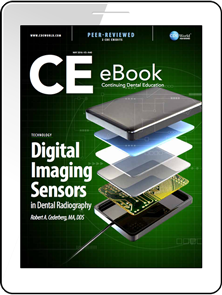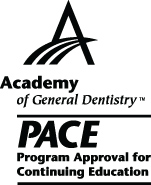CDEWorld > eBooks > Digital Imaging Sensors in Dental Radiography


ADA CERP is a service of the American Dental Association to assist dental professionals in identifying quality providers of continuing dental education. ADA CERP does not approve or endorse individual courses or instructors, nor does it imply acceptance of credit house by boards of dentistry. Concerns or complaints about a CE provider may be directed to the provider or to ADA CERP at www.ada.org/cerp/

Approved PACE Program Provider. FAGD/MAGD credit. Approval does not imply acceptance by a state or provincial board of dentistry, or AGD endorsement. 1/1/2023 to 12/31/2028. ID # 209722.
eBook
Released: Tuesday, June 14, 2016
Expires: Tuesday, April 30, 2019
Digital Imaging Sensors in Dental Radiography
By Robert A. Cederberg, MA, DDS
Commercial Supporter: Air Techniques, Inc.
The sensor is the key component of digital imaging systems used for intraoral radiography. Direct digital image capture using sensors has undergone a progressive evolution since the introduction of these imaging techniques in the 1980s. Direct capture imaging sensors are either solid-state sensors, wired or wireless, or photostimulable storage phosphor (PSP) plates. Both sensor technologies have advantages and disadvantages that the clinician must evaluate when selecting the digital imaging system that best fits the needs of the practice. Solid-state and PSP sensors have many similar properties for image capture, but they also have some dissimilar characteristics that may be determining factors in clinician preference for one sensor over the other. In addition, physical properties, system parameters, and diagnostic qualities of these systems are important considerations. This article describes the evolution of dental imaging sensors, the advantages and disadvantages of various sensors and systems, sensor properties and system parameters, and the diagnostic efficacy of each of the sensor types.
LEARNING OBJECTIVES:
-
Describe the differences between different types of digital image sensors
-
Discuss the performance parameter comparisons between charge-coupled device/ complementary metal-oxide semiconductor and photostimulable phosphor
-
Discuss the sensor dimensions and effects on patient comfort in dental imaging
-
Discuss sensor sensitivity and latitude
About the Author
Dr. Cederberg is the Director of Clinical Education and Quality Improvement and a professor in the Department of General Practice and Dental Public Health at the University of Texas Health Science Center at Houston School of Dentistry.
Download FREE eBook now!

